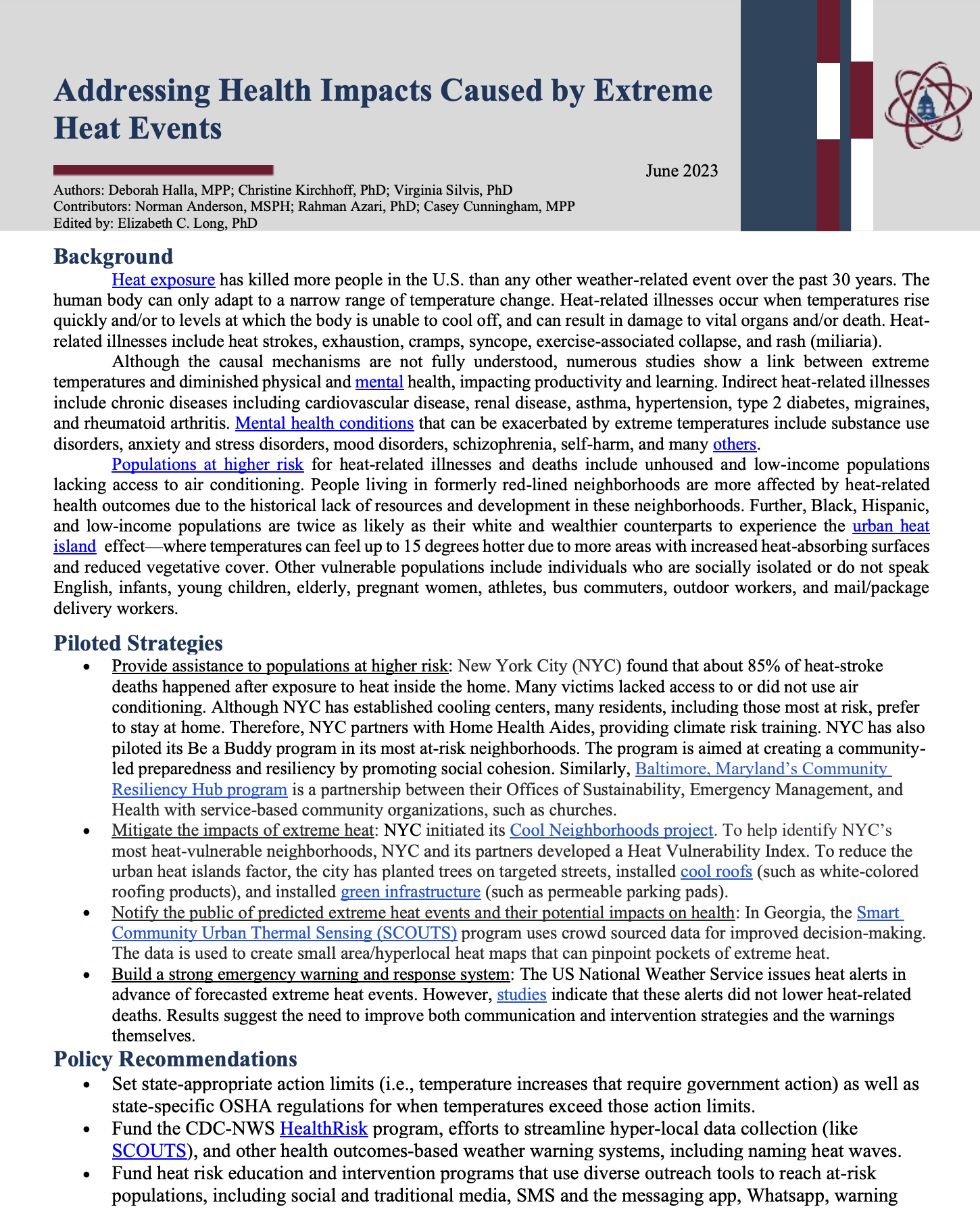
Background
Heat exposure has killed more people in the U.S. than any other weather-related event over the past 30 years. The human body can only adapt to a narrow range of temperature change. Heat-related illnesses occur when temperatures rise quickly and/or to levels at which the body is unable to cool off, and can result in damage to vital organs and/or death. Heat-related illnesses include heat strokes, exhaustion, cramps, syncope, exercise-associated collapse, and rash (miliaria).
Although the causal mechanisms are not fully understood, numerous studies show a link between extreme temperatures and diminished physical and mental health, impacting productivity and learning. Indirect heat-related illnesses include chronic diseases including cardiovascular disease, renal disease, asthma, hypertension, type 2 diabetes, migraines, and rheumatoid arthritis. Mental health conditions that can be exacerbated by extreme temperatures include substance use disorders, anxiety and stress disorders, mood disorders, schizophrenia, self-harm, and many others.
Populations at higher risk for heat-related illnesses and deaths include unhoused and low-income populations lacking access to air conditioning. People living in formerly red-lined neighborhoods are more affected by heat-related health outcomes due to the historical lack of resources and development in these neighborhoods. Further, Black, Hispanic, and low-income populations are twice as likely as their white and wealthier counterparts to experience the urban heat island effect—where temperatures can feel up to 15 degrees hotter due to more areas with increased heat-absorbing surfaces and reduced vegetative cover. Other vulnerable populations include individuals who are socially isolated or do not speak English, infants, young children, elderly, pregnant women, athletes, bus commuters, outdoor workers, and mail/package delivery workers.
Piloted Strategies
- Provide assistance to populations at higher risk: New York City (NYC) found that about 85% of heat-stroke deaths happened after exposure to heat inside the home. Many victims lacked access to or did not use air conditioning. Although NYC has established cooling centers, many residents, including those most at risk, prefer to stay at home. Therefore, NYC partners with Home Health Aides, providing climate risk training. NYC has also piloted its Be a Buddy program in its most at-risk neighborhoods. The program is aimed at creating a community-led preparedness and resiliency by promoting social cohesion. Similarly, Baltimore, Maryland’s Community Resiliency Hub program is a partnership between their Offices of Sustainability, Emergency Management, and Health with service-based community organizations, such as churches.
- Mitigate the impacts of extreme heat: NYC initiated its Cool Neighborhoods project. To help identify NYC’s most heat-vulnerable neighborhoods, NYC and its partners developed a Heat Vulnerability Index. To reduce the urban heat islands factor, the city has planted trees on targeted streets, installed cool roofs (such as white-colored roofing products), and installed green infrastructure (such as permeable parking pads).
- Notify the public of predicted extreme heat events and their potential impacts on health: In Georgia, the Smart Community Urban Thermal Sensing (SCOUTS) program uses crowd sourced data for improved decision-making. The data is used to create small area/hyperlocal heat maps that can pinpoint pockets of extreme heat.
- Build a strong emergency warning and response system: The US National Weather Service issues heat alerts in advance of forecasted extreme heat events. However, studies indicate that these alerts did not lower heat-related deaths. Results suggest the need to improve both communication and intervention strategies and the warnings themselves.
Policy Recommendations
- Set state-appropriate action limits (i.e., temperature increases that require government action) as well as state-specific OSHA regulations for when temperatures exceed those action limits.
- Fund the CDC-NWS HealthRisk program, efforts to streamline hyper-local data collection (like SCOUTS), and other health outcomes-based weather warning systems, including naming heat waves.
- Fund heat risk education and intervention programs that use diverse outreach tools to reach at-risk populations, including social and traditional media, SMS and the messaging app, Whatsapp, warning messages, and that employ public/nonprofit partnerships, including Home Health Aides and neighbor-to-neighbor outreach to at-risk populations.
- Develop climate resilience hubs built on neighborhood-, community- and city-level partnerships, based on the programs listed above.
- Expand Low-Income Home Energy Assistance Program (LIHEAP) and other weatherization programs to enable both installation of more AC units and off-setting of the cost of using AC units. Explore low-cost interventions being piloted, such as portable solar-powered cooling units.
- Encourage cities to appoint a Chief Heat Officer tasked with expanding, accelerating, and coordinating efforts to protect people from heat.
- Develop “climate resilience hubs,” that serve as cooling stations and provide other services such as cell phone charging, free WiFi, preparedness and resiliency training, and energy efficiency technical support.
- Incentivize heat mitigation design and construction, including passive cooling and temperature control (such as cool roofs), efficient HVAC systems, and solar power with battery backup.
The Research-to-Policy Collaboration (RPC) works to bring together research professionals and public officials to support evidence-based policy. Please visit their website to learn more.
Key Information
RPC Website
Research-to-Policy Collaboration
Publication DateJune 1, 2023
Topic Area(s)Equity, Health, Environment and Earth Sciences
Resource TypeWritten Briefs
Share This Page
Background
Heat exposure has killed more people in the U.S. than any other weather-related event over the past 30 years. The human body can only adapt to a narrow range of temperature change. Heat-related illnesses occur when temperatures rise quickly and/or to levels at which the body is unable to cool off, and can result in damage to vital organs and/or death. Heat-related illnesses include heat strokes, exhaustion, cramps, syncope, exercise-associated collapse, and rash (miliaria).
Although the causal mechanisms are not fully understood, numerous studies show a link between extreme temperatures and diminished physical and mental health, impacting productivity and learning. Indirect heat-related illnesses include chronic diseases including cardiovascular disease, renal disease, asthma, hypertension, type 2 diabetes, migraines, and rheumatoid arthritis. Mental health conditions that can be exacerbated by extreme temperatures include substance use disorders, anxiety and stress disorders, mood disorders, schizophrenia, self-harm, and many others.
Populations at higher risk for heat-related illnesses and deaths include unhoused and low-income populations lacking access to air conditioning. People living in formerly red-lined neighborhoods are more affected by heat-related health outcomes due to the historical lack of resources and development in these neighborhoods. Further, Black, Hispanic, and low-income populations are twice as likely as their white and wealthier counterparts to experience the urban heat island effect—where temperatures can feel up to 15 degrees hotter due to more areas with increased heat-absorbing surfaces and reduced vegetative cover. Other vulnerable populations include individuals who are socially isolated or do not speak English, infants, young children, elderly, pregnant women, athletes, bus commuters, outdoor workers, and mail/package delivery workers.
Piloted Strategies
- Provide assistance to populations at higher risk: New York City (NYC) found that about 85% of heat-stroke deaths happened after exposure to heat inside the home. Many victims lacked access to or did not use air conditioning. Although NYC has established cooling centers, many residents, including those most at risk, prefer to stay at home. Therefore, NYC partners with Home Health Aides, providing climate risk training. NYC has also piloted its Be a Buddy program in its most at-risk neighborhoods. The program is aimed at creating a community-led preparedness and resiliency by promoting social cohesion. Similarly, Baltimore, Maryland’s Community Resiliency Hub program is a partnership between their Offices of Sustainability, Emergency Management, and Health with service-based community organizations, such as churches.
- Mitigate the impacts of extreme heat: NYC initiated its Cool Neighborhoods project. To help identify NYC’s most heat-vulnerable neighborhoods, NYC and its partners developed a Heat Vulnerability Index. To reduce the urban heat islands factor, the city has planted trees on targeted streets, installed cool roofs (such as white-colored roofing products), and installed green infrastructure (such as permeable parking pads).
- Notify the public of predicted extreme heat events and their potential impacts on health: In Georgia, the Smart Community Urban Thermal Sensing (SCOUTS) program uses crowd sourced data for improved decision-making. The data is used to create small area/hyperlocal heat maps that can pinpoint pockets of extreme heat.
- Build a strong emergency warning and response system: The US National Weather Service issues heat alerts in advance of forecasted extreme heat events. However, studies indicate that these alerts did not lower heat-related deaths. Results suggest the need to improve both communication and intervention strategies and the warnings themselves.
Policy Recommendations
- Set state-appropriate action limits (i.e., temperature increases that require government action) as well as state-specific OSHA regulations for when temperatures exceed those action limits.
- Fund the CDC-NWS HealthRisk program, efforts to streamline hyper-local data collection (like SCOUTS), and other health outcomes-based weather warning systems, including naming heat waves.
- Fund heat risk education and intervention programs that use diverse outreach tools to reach at-risk populations, including social and traditional media, SMS and the messaging app, Whatsapp, warning messages, and that employ public/nonprofit partnerships, including Home Health Aides and neighbor-to-neighbor outreach to at-risk populations.
- Develop climate resilience hubs built on neighborhood-, community- and city-level partnerships, based on the programs listed above.
- Expand Low-Income Home Energy Assistance Program (LIHEAP) and other weatherization programs to enable both installation of more AC units and off-setting of the cost of using AC units. Explore low-cost interventions being piloted, such as portable solar-powered cooling units.
- Encourage cities to appoint a Chief Heat Officer tasked with expanding, accelerating, and coordinating efforts to protect people from heat.
- Develop “climate resilience hubs,” that serve as cooling stations and provide other services such as cell phone charging, free WiFi, preparedness and resiliency training, and energy efficiency technical support.
- Incentivize heat mitigation design and construction, including passive cooling and temperature control (such as cool roofs), efficient HVAC systems, and solar power with battery backup.
The Research-to-Policy Collaboration (RPC) works to bring together research professionals and public officials to support evidence-based policy. Please visit their website to learn more.

Key Information
RPC Website
Research-to-Policy Collaboration
Publication DateJune 1, 2023
Topic Area(s)Equity, Health, Environment and Earth Sciences
Resource TypeWritten Briefs
Share This Page
LET’S STAY IN TOUCH
Join the Evidence-to-Impact Mailing List
Keep up to date with the latest resources, events, and news from the EIC.




